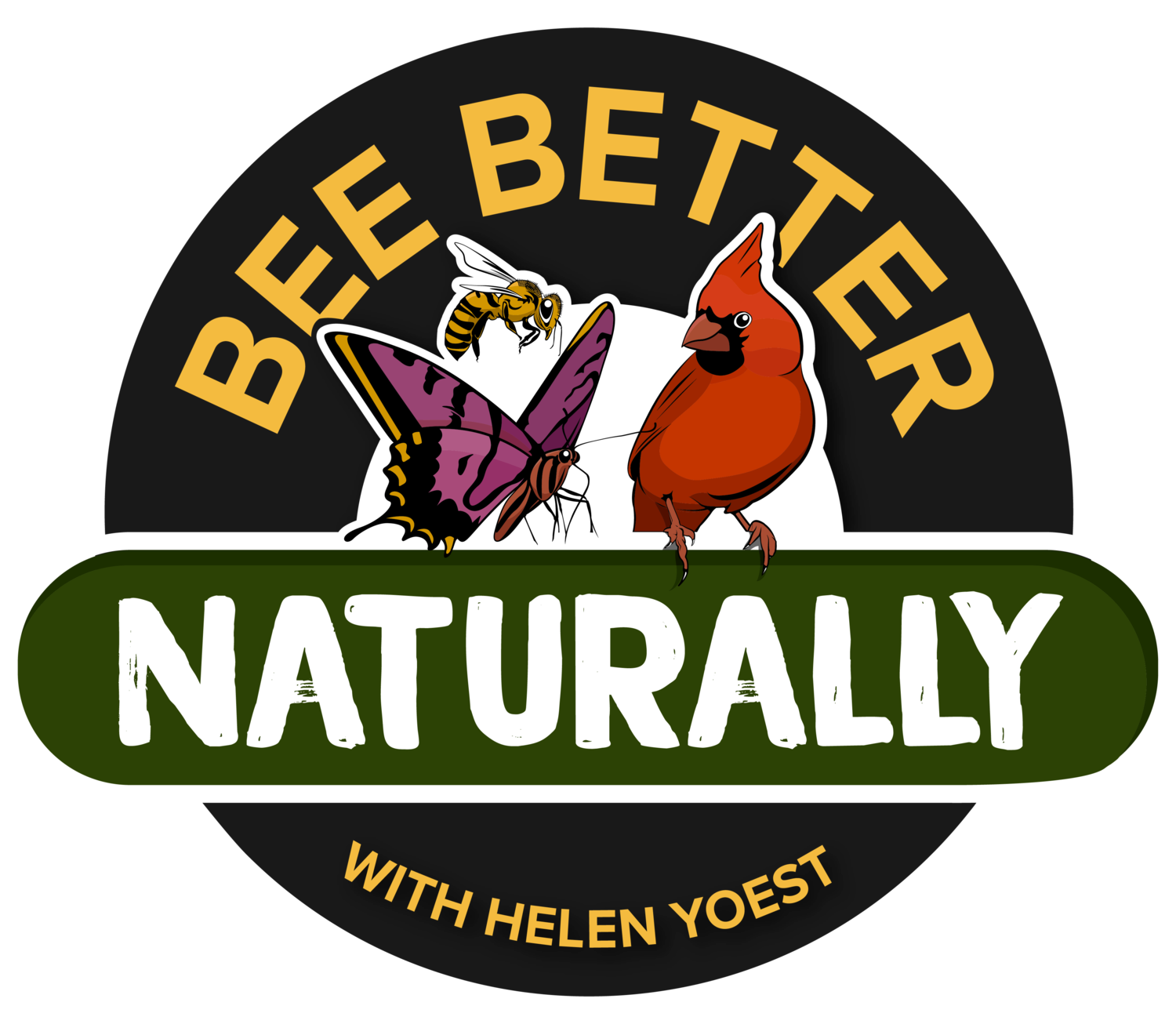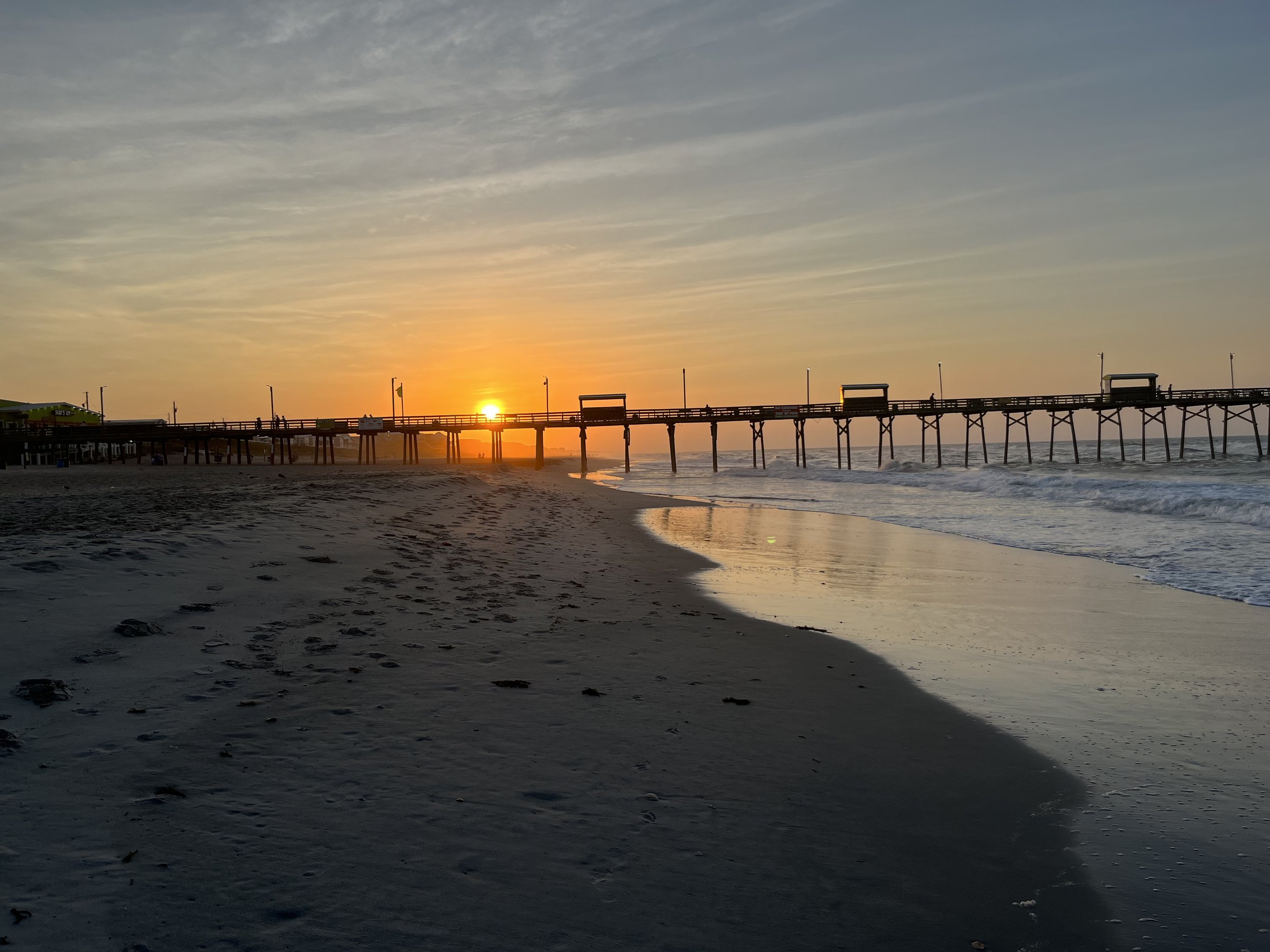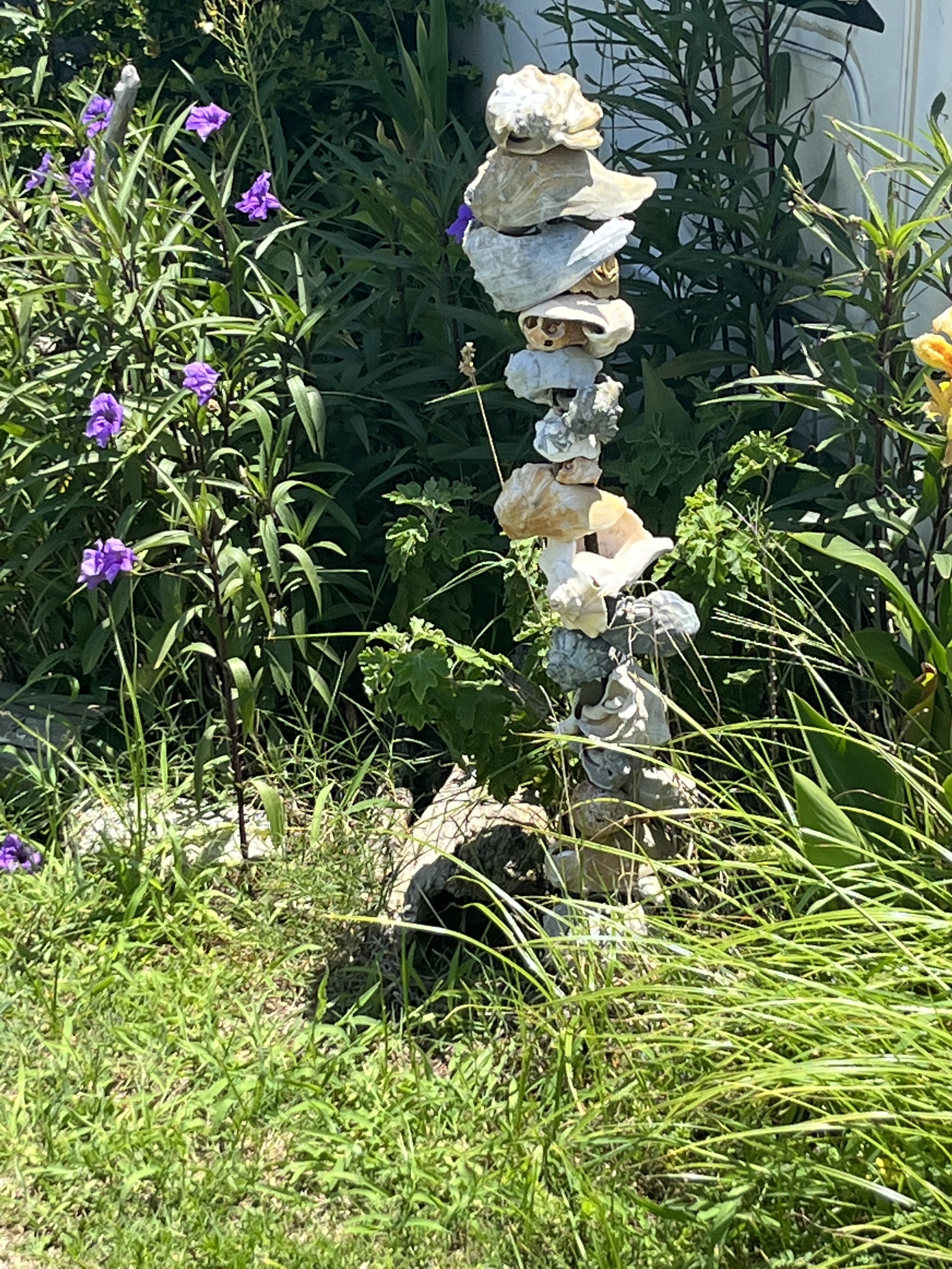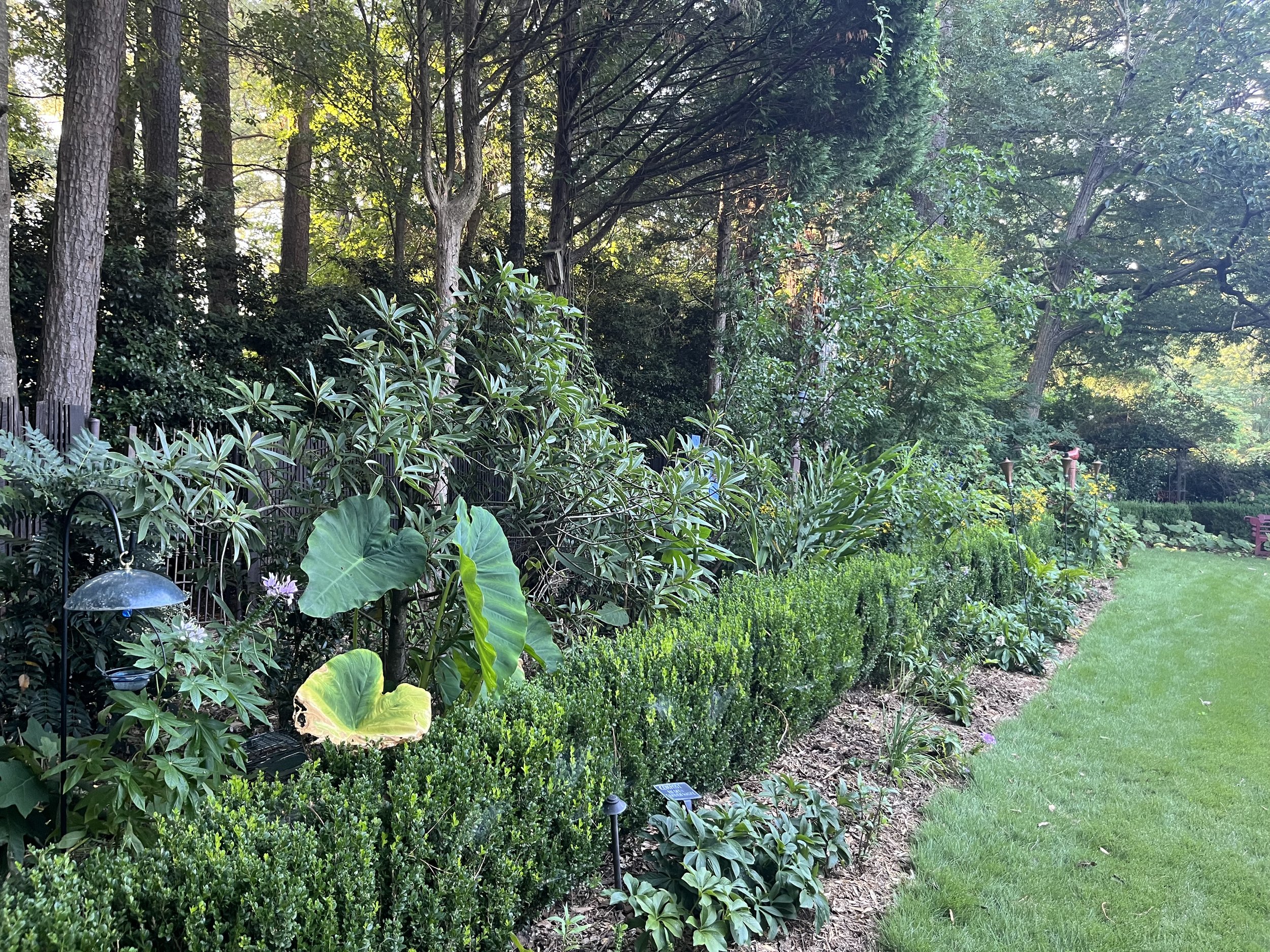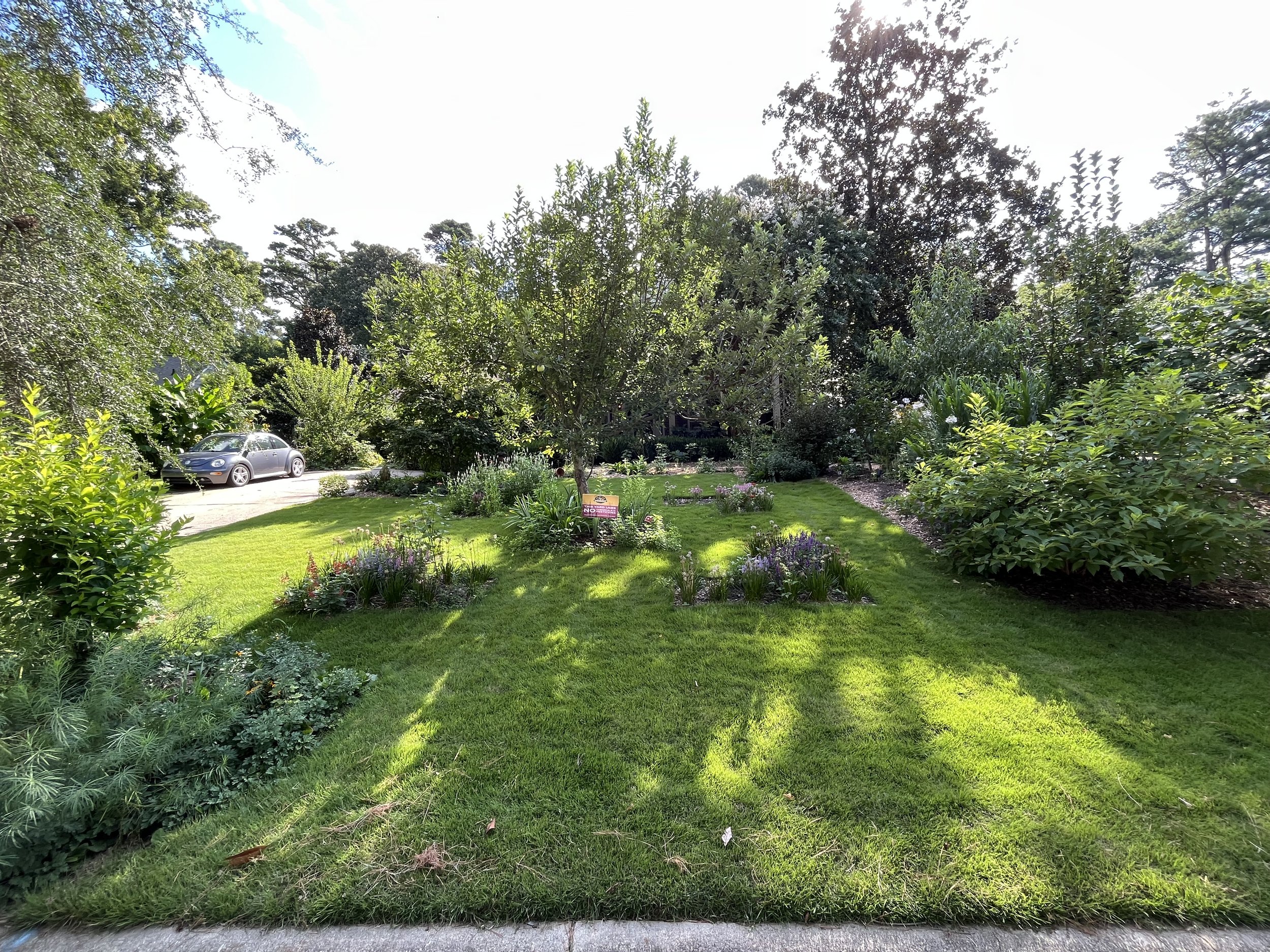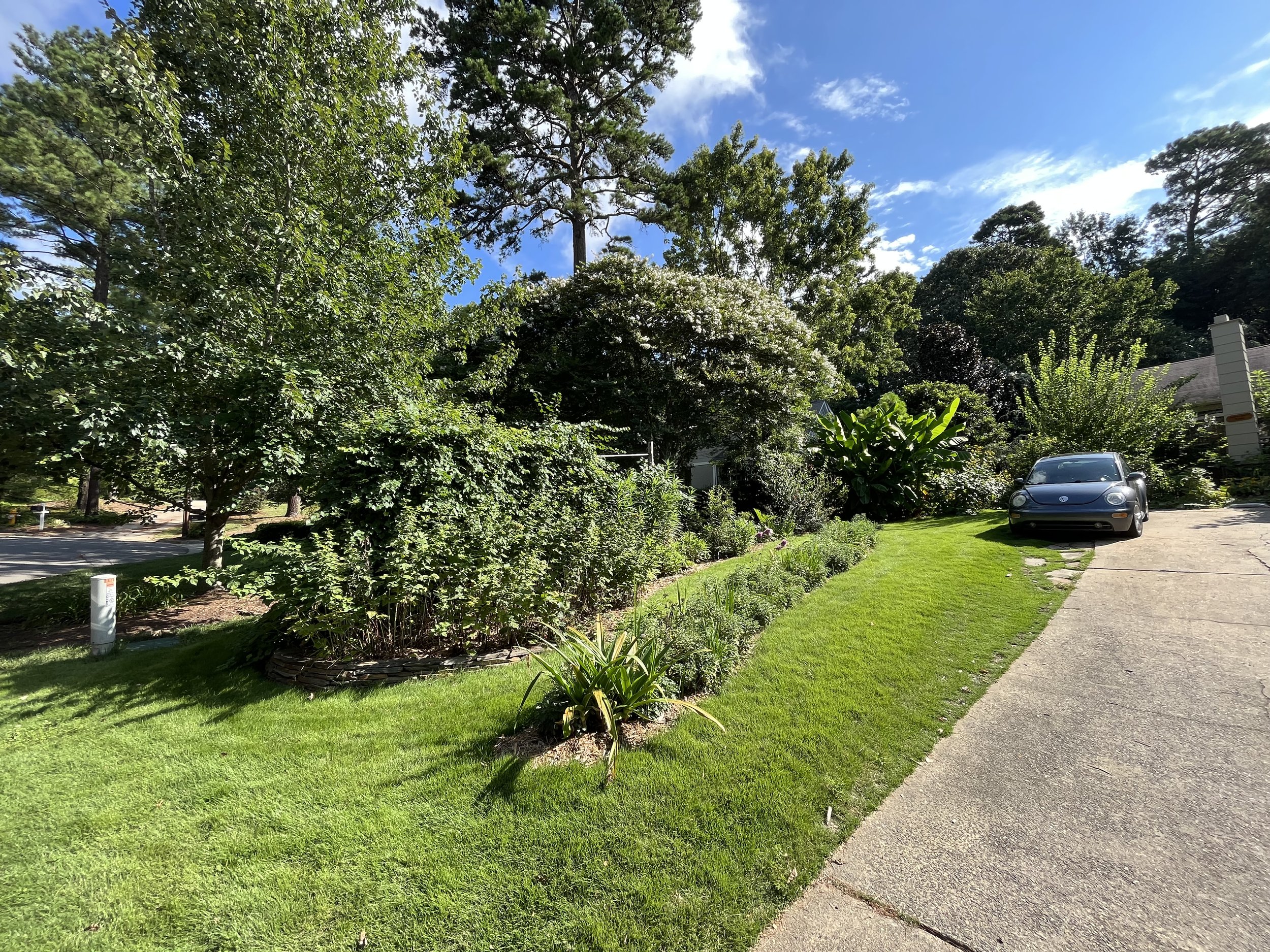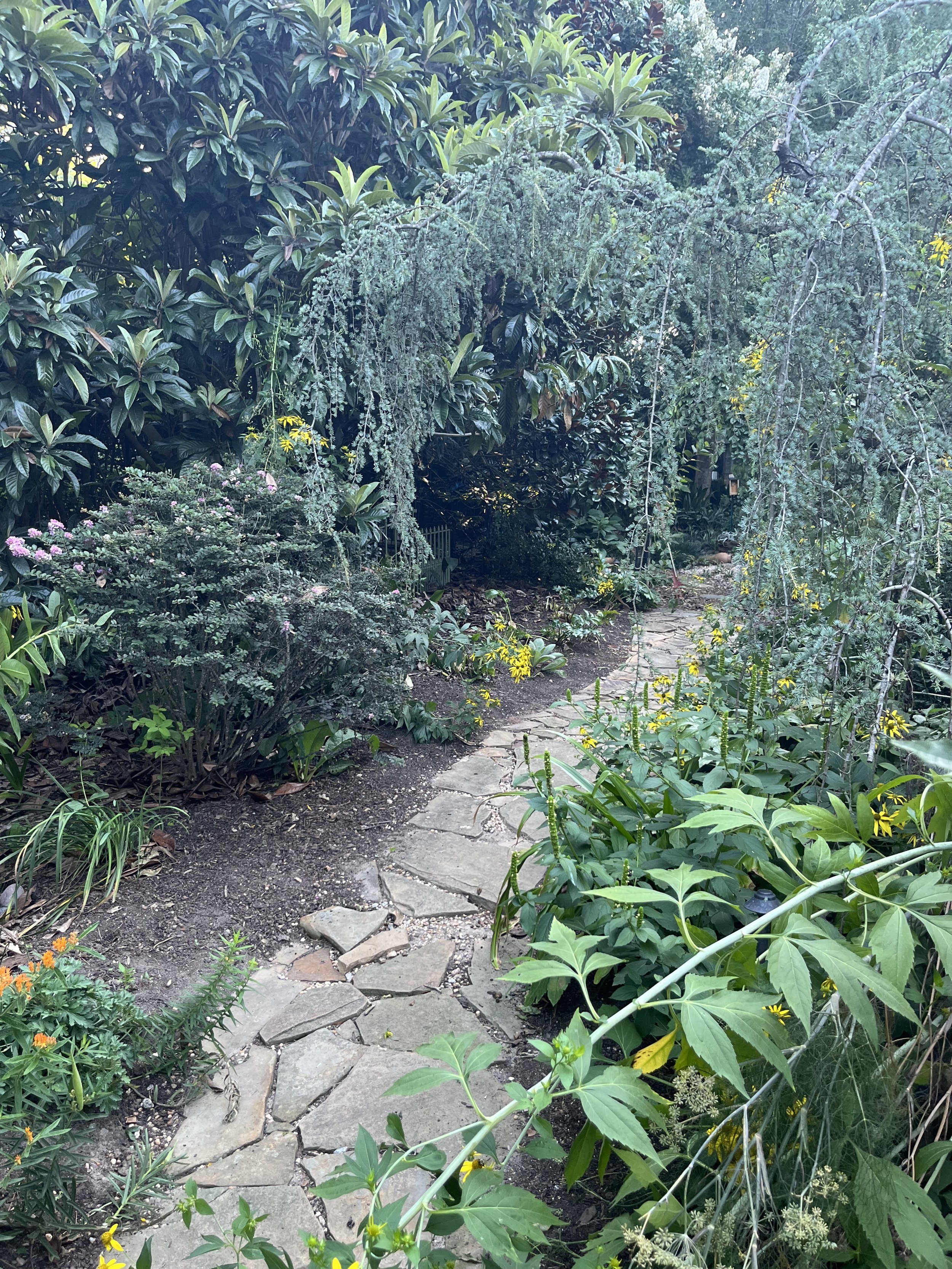AUGUST
Sunrise turtle walk. I love these mornings.
For me, the best part of August is that it ends July for another year. It has been a particularly hot summer. There were many days at work when working with volunteers I had to call it. Call it? It means we have had enough for today. It’s too hot to continue. But that doesn’t mean I hide in the house. I run errands, go to meetings, pick up plants, and then inside to work on The Joslin Garden weekly blog post or make additions to The Joslin Garden plant database.
A particularly fun evening with my friend and boss, Lauren. Here we are at Kathryn’s.
Back to gardening. I do have to weed at the beach! I mowed yesterday. It was long overdue. Our community has a mower we can use, and it worked great. This was my first time using it.
Found this totem at the beach. I’m totally copying it!
The Back 40 (ft) North to South. Worked 1/2 the Soccer field edging. Weeded, deadheaded, dead leafed, and scratched the soil. Mulched back in March. Still looks good.
The Back 40 (ft) South to North
Gazebo Corner
The Epimedium Patch Last month, I ordered seven Epimedium × rubrum from Digging Dog Nursery. The plants were in excellent shape. I’ve ordered from them before and have never been dissatisfied. The only problem was I wasn’t the only one who liked them. The rabbits took them down as soon as I turned to get the rabbit deterrent spray! I’ve met no one who hasn’t commented on the increased number. It’s been terrible.
The Wildflower Patch Extension
The Wildflower Patch.
The Southside. Put back banana shrub, pyracantha, and hardy kiwi.
The Ostrich Fern Garden. Move Virginia Gibbons to back of cleaned out area. Need to add more Ostrich ferns. Reworked the bed—weeded, scratched soil, managed magnolia leaves. Trimmed limbs off the camellia.
The Front Fountain Garden. Today, I began renovating the Fountain Garden. The winged elm was stretching over the fountain, the hydrangea Vivian Philips gave me never look good where it was. Took out an azalea and cotoneaster. Trimmed up spicebush and Loropetalum. Severely cut back winged elm. This really opened things up giving me more room in the Ostrich Fern Patch.
The Blackberry Patch with Chimney Swift Tower
The Food Forest. Weeded and evaluated which of my fruit trees will need to be cut this winter to keep they in picking high.
Food Forest from another angle.
Food Forest Extension. Weeded, scratched soil. I’ll add mulch next month, maybe. Once it was scratched, it looks nice again.
The Front Beds—Once a year, I clear out the magnolia, Magnolia grandiflora leaves from this bed. There are still plenty, but having them under the tree is OK with. me. But in other beds? I don’t thinks so. It takes about a year to get me anxious enough to clean up. July is a good time to do so, since the tree is always shedding, but mostly in May and June.
The creeping fig also got its annual haircut.
The Parterre
Rock Garden
The Raspberry Patch and River Bed
The Pollinator Garden
The Blackberry Patch
North Side. Cut back acanthus leaves. This is the time of year to do so.
The Girl’s Garden
The Wildlife Pond.
Mixed Border, South to North.
Mixed Border, North to South.
To read more of my writings, click HERE!
SCROLL TO THE END TO SEE WHAT’S IN BLOOM!
Have a Gardening Need? HIRE HELEN!
SUSTAINABLE GARDENING STEWARDSHIP:
There are many definitions of sustainable gardening, and through my decades as a sustainable gardener, I’ve summed it up to mean…wait for it…a garden that sustains itself and the life within! By that, I mean doing less, so much less, that it can take away the stress and much of the labor, bringing back the joy of gardening and bettering the environment.
Sustainable gardening is a concept of using gardening practices that cause no harm to the Earth and its inhabitants while working in a way to enhance it. But there is more. To me, sustainable gardening is to have within all the aspects to sustain life. For example, having a butterfly garden is not enough to just have pretty nectar-rich flowers. For a butterfly garden to be fully sustainable, plants must sustain all aspects of the butterfly’s life cycle. That means providing host plants, specific plants that area butterflies need to lay their eggs. So yes, you will have holes in your leaves; that’s the goal!
Simply put, sustainable gardening is designing your garden to sustain itself and allows us to secure our future to make the Earth better than we found it. Think of it as organic gardening taken a step further.
Design becomes an important aspect for a garden to sustain itself, as well as providing the plants necessary to fully sustain wildlife in all respects of their lifecycle. You could just plant plants that are regionally native and provide exactly what nature does. No supplemental water, no cutbacks, no added mulch, and no pesticides or herbicides. Yet, many want more from their gardens, so we add plant diversity. What is key is the placement of these plants.
SOIL
FERTILIZING SUSTAINABLY
WATERING SUSTAINABLY
WATERWISE
WILDLIFE
CREATING A WILDLIFE HABITAT AT HOME
FOOD:
Our bird friends don’t need supplemental feed if you have a diverse garden. but we begin to heat up, keep up the feeder so you can watch your feathered friends from the inside of the home..
One of the best all-around seeds for birds is the black-oil sunflower. This seed has a high meat-to-shell ratio, it is high in fat, and it is sized perfectly for many seed eaters, including black-capped chickadees, cardinals, mourning doves, finches, juncos, jays, woodpeckers, and sparrows.
COVER:
Wildlife welcomes cover, year-round.
WATER:
As the berries in our area ripen, the birds are having a feast. Keep your birdbaths filled with freshwater, changing out at least every four days to break the mosquito larvae cycle.
PLACES TO RAISE THEIR YOUNG:
Plant diversity is key!
BIRDCARE:
Do you deadhead? Click HERE to learn more.
Check out this really nice bird identification and preferred foods for each bird from The Cornell Lab! Click HERE!
Are you familiar with how we can bring the birds back? Click HERE for starters.
As long as you are enjoying seeing the birds from your window, continue to Feed The Birds!
I also fill wire suet cages with native grasses for nesting birds.
HUMMINGBIRD UPDATE:
The males left last month. Females will leave in a month or two afterward. To learn how to attract hummingbirds to your garden, click HERE.
INVASIVE PLANTS:
Invasive Plants:
By definition, did you know there is a different meaning between invasive plants vs. aggressive plants? A simple definition is invasive plants are introduced species not native to our area and tend to spread out of control. Aggressive plants are those native to our area, and some can easily take over. We in. The Bee Better Teaching Garden, keep an eye on both!
Clover
We don’t all think of clover as a weed. I certainly don’t! Do you think white clover is a weed? Think again. if you are one of the ones who want it gone on your turf, click HERE.
You may know pokeweed as American pokeweed, poke sallet, or dragonberries. All parts of the plant are poisonous, except when the foliage is about the height of a spread hand. Then it can be boiled with two water changes and eaten like cooked spinach.
Birds highly desire the berries in the fall, which help spread pokeweed as they drop the seeds—everywhere! After consuming the berry, the seeds are spread by birds and frequently are found around the driplines of trees, shrubs, and along fencerows, and a massive amount around the plant.
If left too big, they can be hard to remove since they have a deep taproot. Try to note and remove seedlings early for an easier pull.
Pokeweed shoots can be composted in cold piles if berries are not present. Roots should not be added to cold piles, either. We cold compost in the Bee Better Naturally Teaching Garden. Cold composting is essentially letting a pile build and decompose. It requires less effort from the gardener, yet the decomposition takes substantially longer—a year or more. We have a designated area behind some shrubs where we pile our biomass to break down slowly.
I thought you might be interested in learning how the dreaded Bradford pear had its beginning.
Lesser Celandine or Fig Buttercup, Ficaria verna
Creeping Charlie, Glechoma hederacea
Greenbriar, Smilax rotundifolia
Hairy Bittercress, Cardamine hirsura
Marsh Pennywort, Hydrocotyle sibthorpioides
GOOD BUGS:
An Introduction to Green Lacewings
Mysteries of the Dragonfly and Damselfly
BUTTERFLY UPDATE:
I’ve seen a few, but they are slow to arrive full force in July. In August we should start seeing them regularly. Recently, I registered the Bee Better Teaching Garden with the Rosalynn Carter Butterfly Trail. Have you looked into this?
We offer Caterpillar Support to those who need butterfly caterpillars rescued. If you have butterfly caterpillars running out of host plants, or if you don’t want your plant defoliated, just email me at helenyoest at gmail.com. We can arrange for you to drop them off, and I will raise and release them.
Host Butterfly Plants
Bronze fennel is the host butterfly plant for the Eastern black swallowtail butterfly. The caterpillars feed on the fennel until time for the metamorphosis.
Our area doesn’t tend to see Eastern black swallowtails until a little later in the summer. But they will come. It’s not too late to plant their host plants. While they like fennel best, the caterpillars will also feed on curly parsley, dill, and carrot tops. Click HERE to purchase the full list of host plants for butterflies within our Ecosystem 231.
MONARCH UPDATE:
Friends have shared with me monarch sightings, but I haven’t seen one yet. We have plenty of milkweeds, their only host plant genus, so we are ready. We are more likely to see a bunch of them in the fall as they migrate south again. Have you planted your milkweed?
BAD BUGS:
Mosquitoes are out, these are buggers one never gets used to. Controlling mosquitoes with traps has been most helpful. To learn more, click HERE!
Tent Caterpillars
Leaf Miner Flies
Mosquito Control—Is there Such a Thing?
Naturally Controlling Japanese Beetles
Bagworms
Do yourself a favor and never look into the “eye” of a bagworm. Bagworms have got to be the most disgusting-looking pests ever — to me anyway.
Bagworms can be treated by removing them by hand and dropping them into a bucket of soapy water. If the bagworm infestation isn’t within easy reach, they can be sprayed with Bacillus thuringiensis or Bt for short.
Bt is a microbial insecticide commonly used to control various caterpillars such as the red-headed azalea caterpillar and many other caterpillars, as well as those nasty bagworms. But remember, it will also kill our moth and butterfly larvae!
Black Widowed Spider, Latrodectus mactanse
Cicada Killer, Sphecius specious
Japanese Beetle, Popillia japonica
Check them FIRST to see if they have any tanchid fly eggs on their shoulders. If they do, let them go and the flies will hatch out and consume them from the inside — and produce more flies to dispatch more Japanese beetles. If you see those opaque white dots — one or two or three or more — let them go.”
Brown Recluse Spider Loxosceles reclusa
CHECK OUT Bee Better Naturally’s HOW-TOS!
CHECK OUT our SHOP/WORKSHOPS!
SPECIFICALLY…
CAMELLIAS
LAWNS
ROSES
TREES: Check out the latest advice from Leaf & Limb!
Why Dead Wood is Good Wood!
The Art of Espalier
SHRUBS:
The best time to prune flowering shrubs is right after they bloom.
ANNUALS:
I don’t tend to plant annuals, but I’m big on direct sowing. Zinnia’s are my go-to seeds. There are tall ones, shorter ones, and even ground cover types. Some look like show mums, others like pinwheels, and you will want to pluck those like daisies to see if your lover loves you.
PERENNIALS:
Rohdea japonica is sending up new shoots. Now is a good time to cut back old leaves. Same with cast-iron plant, Aspidistra elatior. Cut back dead leaves to welcome fresh foliage.
BULBS:
Divide irises: Did you have success with your new iris planted this year or in the fall? If not, it could be due to several factors: too much shade, too much fertilizer, too deep a planting, or crowding. Now is a good time to correct problems by lifting and relocating or repositioning to a more favorable location.
Plant the iris high with the rhizomes along the surface of the dirt. They can be covered finely and lightly with mulch, but not soil. Make sure you can either see the rhizomes or have the ability to brush away the mulch exposing the root. Except for the Louisiana variety, irises need six- to eight- hours of sunlight to bloom and require good drainage. Plant a Louisiana iris if you have a damp, partial sun location in your garden.
Camellias
Caladiums
VINES:
Virginia creeper, Parthenocissus quinquefolia. I find most people absolutely hate it for the aggressiveness. I happen to find it extremely beneficial for birds in the fall. Did you know Virginia Creeper is a native?
Unfortunately, too many gardeners confuse it with poison ivy, Toxicodendron radicans, which is also a native and feeds birds. I get it. I’m highly allergic to poison ivy and have eradicated it from my property. I remember when I did so, I wasn’t allergic before but became so during its removal. The good/bad news was I did it all in one day, so I was affected even before the symptoms showed up! Otherwise, I may have stopped short of getting rid of it all and being fearful my entire life in the garden! I had a rash from head to toe!!! It was then, in 1997, that I started wearing long sleeves and pants whenever gardening.
Crossvine, Bignonia capreolata; Lady Banks rose, Rosa banksiae; Carolina jessamine, Gelsemium sempervirens.
POND:
EDIBLE FOODS and FOOD FOREST:
Bee Better Teaching Garden grows at least 30 different fruits. Learn about our Food Forest HERE!
HERBS:
What’s looking good now in the Bee Better Teaching Garden:
Parsley, Petroselinum crispum-
Rue, Ruta graveolens
Thyme, Thymus vulgaris
Oregano, Origanum vulgare
Rosemary, Salvia rosmarinus, formally Rosmarinus Officinalis.
In the Food Forest, the rosemary has spider mites.
Without looking at this plant with a hand lens, it’s impossible to be sure, but this type of mottled leaves is typical of the damage done by a sucking insect or spider mites. The leaves ended up stippled and paled with such infestations because the insect or mite pierce the leaf repeatedly as they feed, which kills the cells in the leaf. Initially, the leaves look stippled, but the entire leaf can die over time.
Leafhoppers, lacewings, and whitefly are three insects that suck plant juices and cause similar damage. If you look closely, or with a hand lens, and see webs, it’s likely spider mites are the cause.
Since most people want to eat their herbs, you don’t want to use systemic or other chemical insecticides. Also, mites aren’t killed by some insecticides. However, you could use one of the insecticide/miticides made from neem or cinnamon. Another good practice in such situations is to spray the plant with a hard stream of water once a week.
PERENNIALS:
Salvias
Foxgloves
Phlox
CHICKENS:
SNAKES: Wondering what snake is in your backyard? Click HERE for an easy id.
Glossary
Until soon,
Helen
#WeCanAllBeeBetter!
